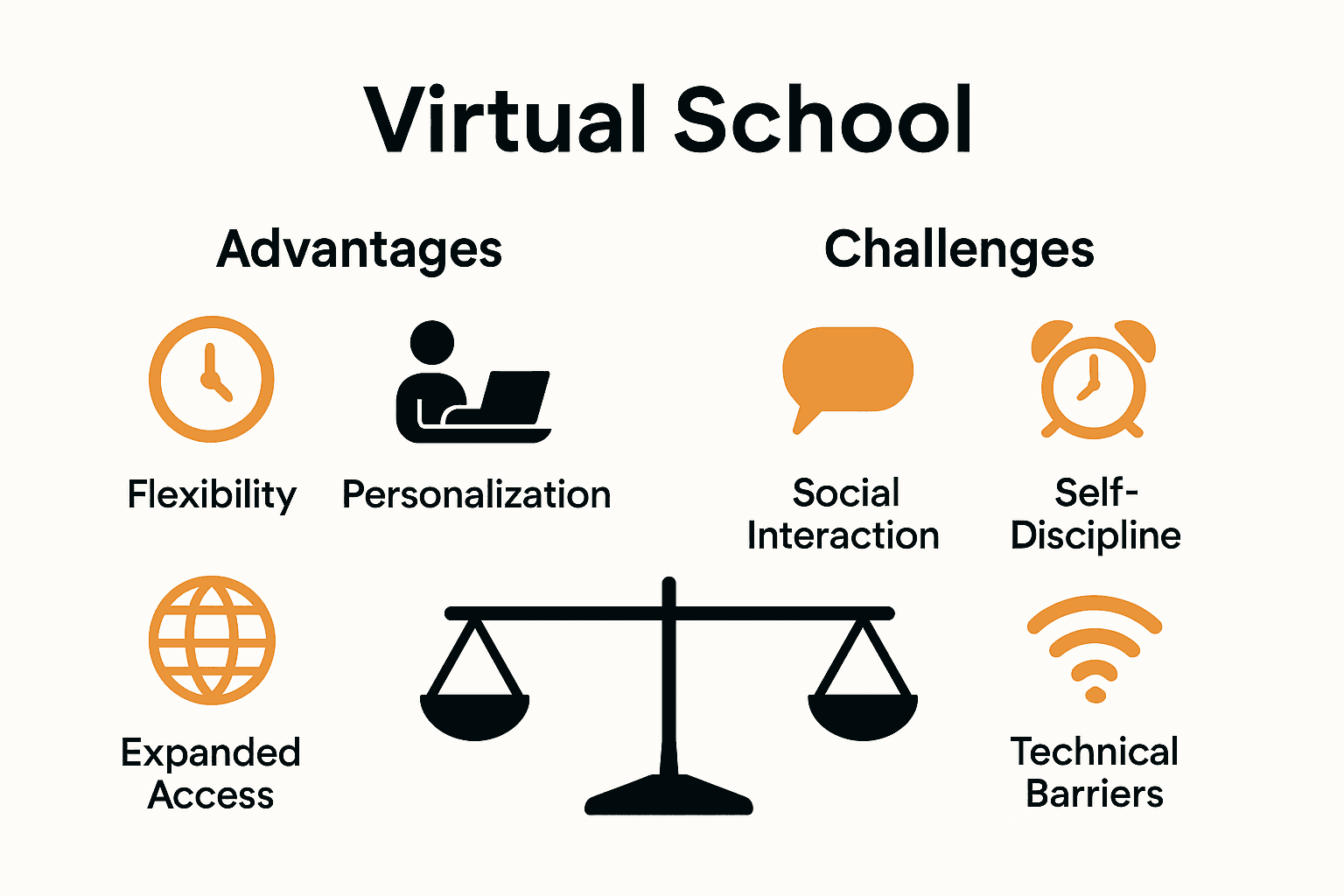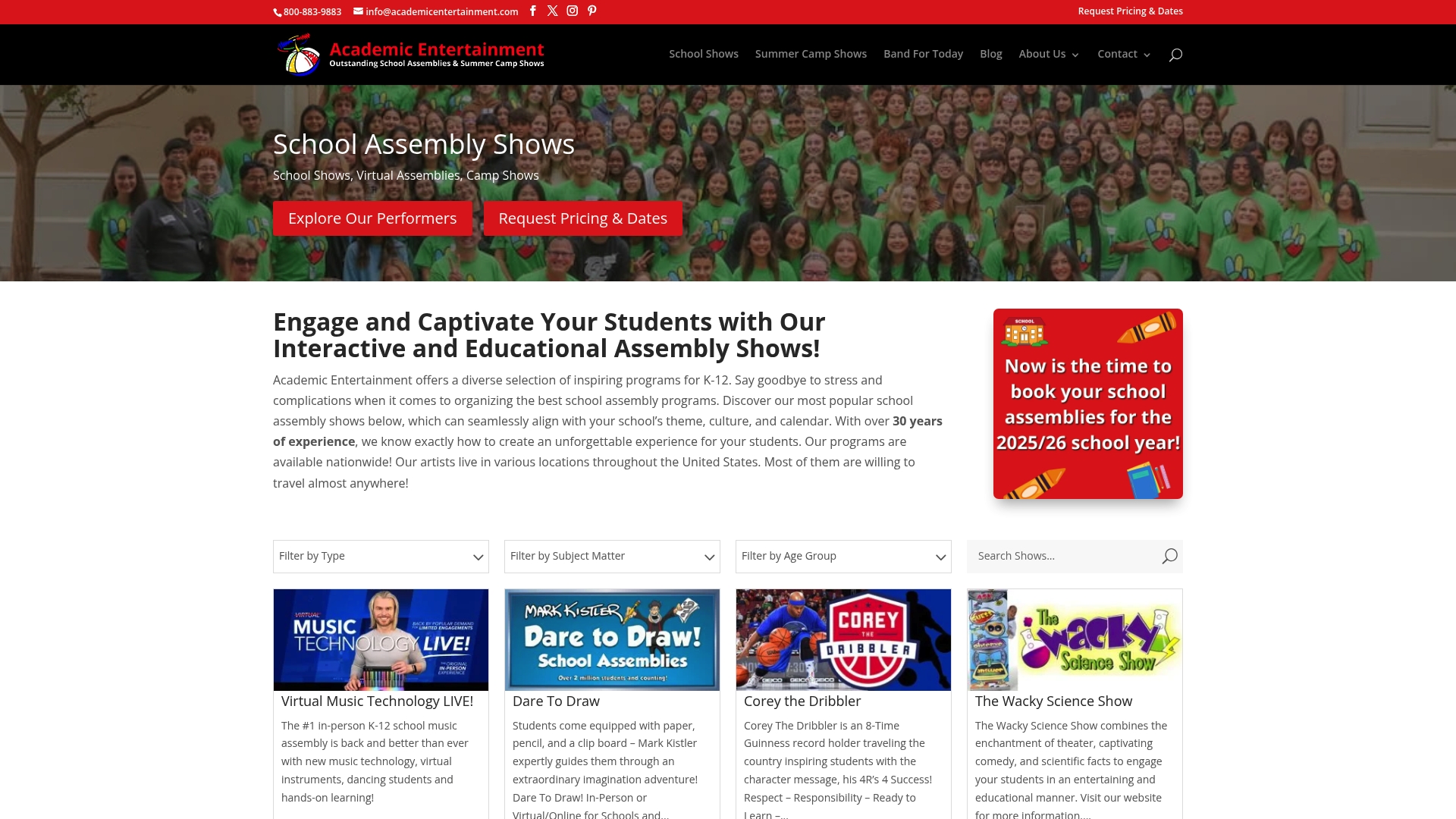Nearly 70 percent of school districts worldwide now offer some form of virtual learning. This rapid rise is changing the way students access education, breaking down barriers caused by distance, limited resources, or unique learning needs. Understanding virtual school programming helps families and educators create more flexible, personalized learning journeys that fit modern challenges.
Key Takeaways
| Point | Details |
|---|---|
| Accessibility and Flexibility | Virtual school programming offers unprecedented access to education, accommodating diverse learners through flexible learning options and personalized experiences. |
| Diverse Program Types | K-12 virtual school programs include full-time, supplemental, blended, credit recovery, and specialized courses to cater to various educational needs. |
| Critical Components | Successful virtual programming relies on robust digital systems, interactive tools, and effective communication channels to enhance student engagement. |
| Balancing Advantages and Challenges | While offering flexibility and personalized learning, virtual schools face challenges including limited social interaction and the need for self-discipline among students. |
Defining Virtual School Programming and Its Purpose
Virtual school programming represents a dynamic educational approach that leverages digital technologies to deliver learning experiences beyond traditional classroom boundaries. According to research from the World Bank, these programs have emerged primarily to address critical educational challenges like teacher shortages, support for at-risk students, and reaching geographically remote populations where physical school infrastructure is limited.
At its core, virtual school programming enables unprecedented accessibility for diverse learners. As highlighted by LeadAZ’s research, these digital platforms offer remarkable flexibility by providing recorded lectures, adaptive learning pathways, and inclusive educational models that accommodate students with varied learning needs, disabilities, or geographical constraints. This approach transforms education from a one-size-fits-all model to a personalized, adaptable learning experience.
Key features of virtual school programming typically include:
- Self-paced learning modules
- Interactive online classrooms
- Multimedia educational content
- Real-time collaboration tools
- Comprehensive digital assessment systems
The purpose extends beyond mere technological convenience. Virtual school programming represents a strategic response to evolving educational landscapes, empowering students to learn effectively regardless of physical, temporal, or geographical limitations. Understanding the Guide to Virtual School Shows can provide deeper insights into how these innovative programs are reshaping educational delivery.
Types of Virtual School Programs for K-12 Students
Virtual school programs for K-12 students have evolved into diverse models that cater to different educational needs and learning styles. State-run programs like the North Carolina Virtual Public School demonstrate how comprehensive online education can be, offering free virtual learning options when traditional face-to-face instruction is unavailable.
These programs typically fall into several distinct categories:
Here’s a comparison of common types of virtual school programs for K-12 students:
| Program Type | Description | Typical Features |
|---|---|---|
| Full-Time Virtual Schools | Complete online curriculum Daily instruction | Self-paced modules Interactive classes Full subject coverage |
| Supplemental Online Courses | Add-on classes to support traditional schooling | Flexible schedules Enrichment options Single-subject focus |
| Blended Learning Models | Mix of online and in-person learning | In-person sessions Digital coursework Collaborative tools |
| Credit Recovery Programs | Courses to retake or make up credits | Accelerated pacing Targeted instruction Progress tracking |
| Specialized Academic Programs | Focused courses in key areas (e.g., STEM, AP) | Advanced content Project-based learning Expert instructors |
- Full-Time Virtual Schools: Comprehensive online programs providing complete curriculum and daily instruction
- Supplemental Online Courses: Additional classes to complement traditional schooling
- Blended Learning Models: Combining online and in-person educational experiences
- Credit Recovery Programs: Allowing students to retake or complete missed coursework
- Specialized Academic Programs: Focusing on specific subjects like STEM or advanced placement courses
District-based virtual schools like Pasco eSchool in Florida illustrate the flexibility of these programs. They offer versatile enrollment options, including full-time and part-time participation, along with advanced courses such as AP and dual-enrollment programs. K-12 Virtual STEM Shows for Schools can provide additional insights into specialized virtual learning opportunities that enhance these educational models.
The emergence of these diverse virtual school programs reflects a broader educational transformation, providing students with unprecedented access to quality learning experiences regardless of geographical, physical, or scheduling constraints.

How Virtual Programming Works for Schools
Virtual programming transforms educational delivery by leveraging advanced streaming technologies and online platforms to extend learning beyond traditional classroom boundaries. According to research from the World Bank, these innovative approaches support blended learning models that enable remote and underserved students to actively participate in educational experiences.
The operational mechanics typically involve several key components:
- Robust digital learning management systems
- Interactive video streaming platforms
- Real-time collaboration tools
- Comprehensive digital assessment frameworks
- Secure online communication channels
Take the North Carolina Virtual Public School (NCVPS) as a prime example. As documented in their operational model, these programs integrate seamlessly into local school systems, delivering online classes statewide at no additional cost when in-person instruction cannot cover specific subjects or meet unique student needs. This approach demonstrates how virtual programming can fill critical educational gaps and provide flexible learning opportunities.
Schools implementing virtual programming must carefully design infrastructure that supports engaging, interactive experiences. How to Schedule the BEST VIRTUAL School Assemblies offers additional insights into creating dynamic virtual learning environments that keep students motivated and connected, regardless of physical distance.
Advantages and Challenges of Virtual School Programs
Virtual school programs represent a complex educational approach with significant benefits and notable challenges. According to research from EduWik, these innovative learning models offer unprecedented flexibility and personalization that traditional educational systems often struggle to provide.
Key advantages include:
- Flexible Learning Schedules: Students can learn at their own pace
- Personalized Educational Experiences: Adaptive technologies support individual learning styles
- Expanded Course Access: Advanced courses available regardless of geographical limitations
- Digital Literacy Development: Enhanced technological skill-building
- Potential Cost Savings: Reduced transportation and material expenses for families
However, these programs are not without significant challenges. EduWik’s research highlights critical obstacles such as limited social interaction, the need for exceptional self-discipline, potential technical barriers like connectivity issues, and reduced opportunities for extracurricular engagement. Students must be highly motivated and possess strong time-management skills to succeed in virtual learning environments.

To maximize the potential of virtual school programs while mitigating potential drawbacks, schools and families must work collaboratively. Virtual School Programs and Virtual Learning provides additional strategies for creating supportive, effective online educational experiences that balance technological innovation with comprehensive learning support.
Selecting and Booking the Right Virtual Assemblies
Virtual assemblies represent a critical opportunity to enhance student engagement and educational experiences beyond traditional classroom learning. When selecting the right virtual assembly, schools must carefully consider multiple factors that align with their specific educational goals, student demographics, and technological capabilities.
Key considerations for selecting virtual assemblies include:
- Alignment with curriculum and learning objectives
- Age-appropriate content and presentation style
- Interactive and engaging presentation formats
- Technical compatibility with school’s digital infrastructure
- Speaker or performer’s educational credentials
- Program’s ability to support diverse learning styles
Technology readiness plays a crucial role in successful virtual assembly implementation. As research from EduWik emphasizes, schools must ensure reliable digital platforms and robust technological infrastructure to support seamless virtual experiences. This involves evaluating streaming quality, interactive capabilities, and potential backup communication channels to prevent disruptions during the event.
Ultimately, the most effective virtual assemblies transform educational entertainment into meaningful learning opportunities. Virtual Assemblies ARE the Future of Educational Entertainment offers deeper insights into selecting programs that captivate students while delivering substantive educational content across various subjects and interests.
Empower Virtual Learning With Engaging School Programs
Ensuring that virtual school programming truly inspires and connects with every student can be a challenge. Many schools face obstacles like keeping students engaged, delivering meaningful lessons outside the classroom, and offering memorable experiences that go beyond textbooks. The need for flexible, interactive, and impactful programming is greater than ever as schools seek to reach diverse learners and address issues such as social interaction, student motivation, and character development highlighted throughout this guide.
Imagine infusing your virtual curriculum with dynamic science, music, and character education shows that spark curiosity and participation. At Academic Entertainment, you get access to an extensive selection of virtual assemblies and all-in-one school programs specifically designed to support virtual and blended learning environments. Our programs make it easy to reinforce key concepts, promote positive behaviors, and create an inclusive school culture—addressing the pain points mentioned in your journey toward effective virtual education. You can also explore how Virtual School Programs and Virtual Learning and Virtual Assemblies ARE the Future of Educational Entertainment can help you achieve your goals.

Ready to bring extraordinary virtual programming to your school? Browse our full catalog at Academic Entertainment, choose a program that fits your needs, and make virtual learning truly unforgettable. Act now to inspire your students and see the impact of immersive virtual events firsthand.
Frequently Asked Questions
What is virtual school programming?
Virtual school programming refers to an educational approach that utilizes digital technologies to provide learning experiences outside conventional classroom settings. It aims to address challenges like teacher shortages and accessibility issues for diverse learners.
What types of virtual school programs are available for K-12 students?
Virtual school programs for K-12 students include full-time virtual schools, supplemental online courses, blended learning models, credit recovery programs, and specialized academic programs focused on specific subjects like STEM or advanced placement.
How does virtual programming work for schools?
Virtual programming employs digital learning management systems, interactive video streaming platforms, and collaboration tools to facilitate remote education. Programs integrate with local school systems to offer accessible online classes when in-person instruction is unavailable.
What are the advantages and challenges of virtual school programs?
Key advantages of virtual school programs include flexible learning schedules, personalized educational experiences, expanded course access, and potential cost savings. Challenges may involve limited social interaction, the need for self-discipline, and potential technical issues that can impact learning.




